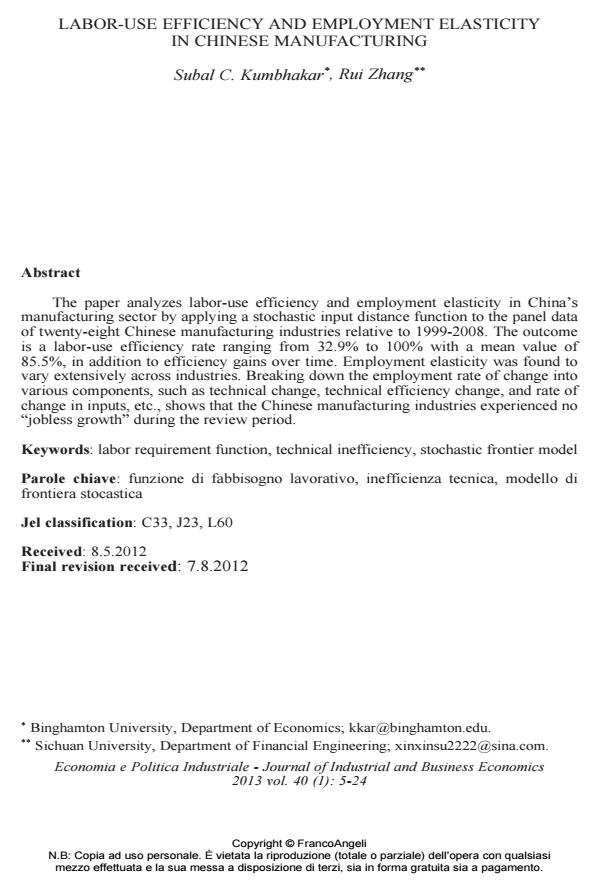Labor-use efficiency and employment elasticity in Chinese manufacturing
Journal title ECONOMIA E POLITICA INDUSTRIALE
Author/s Subal Kumbhakar, Rui Zhang
Publishing Year 2013 Issue 2013/1 Language Italian
Pages 19 P. 5-23 File size 480 KB
DOI 10.3280/POLI2013-001001
DOI is like a bar code for intellectual property: to have more infomation
click here
Below, you can see the article first page
If you want to buy this article in PDF format, you can do it, following the instructions to buy download credits

FrancoAngeli is member of Publishers International Linking Association, Inc (PILA), a not-for-profit association which run the CrossRef service enabling links to and from online scholarly content.
The paper analyzes labor-use efficiency and employment elasticity in China’s manufacturing sector by applying a stochastic input distance function to the panel data of twenty-eight Chinese manufacturing industries relative to 1999-2008. The outcome is a labor-use efficiency rate ranging from 32.9% to 100% with a mean value of 85.5%, in addition to efficiency gains over time. Employment elasticity was found to vary extensively across industries. Breaking down the employment rate of change into various components, such as technical change, technical efficiency change, and rate of change in inputs, etc., shows that the Chinese manufacturing industries experienced no "jobless growth" during the review period. Keywords: labor requirement function, technical inefficiency, stochastic frontier model
Keywords: Funzione di fabbisogno lavorativo, inefficienza tecnica, modello di frontiera stocastica
Jel codes: C33, J23, L60
- Aigner D., Lovell C., Schmidt P. 1977. Formulation and estimation of stochastic frontier production function models. Journal of Econometrics, 6 (1): 21-37, DOI: 10.1016/0304-4076(77)90052-5.
- Banister J. 2005. Manufacturing employment in China. Monthly Labor Review, 128 (11): 11-29.
- Barba Navaretti G., Checchi D., Turrini A. 2003. Adjusting labour demand: multinational versus national firms. A cross-European analysis. Journal of the European Economic Association, 1 (2-3): 708-719 DOI: 10.1162/154247603322391332.
- Battese G., Heshmati A., Hjalmarsson L. 2000. Efficiency of labour use in the Swedish banking industry: a stochastic frontier approach. Empirical Economics, 25 (4):623-640 DOI: 10.1007/s001810000037.
- Coelli T., Rao D., Battese G.E. 1998. An Introduction to Efficiency and Productivity Analysis. Kluwer Academic Publishers: Boston DOI: 10.1007/978-1-4615-5493-6.
- Diewert W. 1974. Functional forms for revenue and factor requirements functions. International Economic Review, 15 (1): 119-130 DOI: 10.2307/2526093.
- Fang M., Nie H., Jiang T., Tan S. 2010. An estimate of employment elasticity in manufacturing enterprises in China. World Economy, 8: 3-16.
- Greenaway D., Hine R.C., Wright P. 1999. An empirical assessment of the impact of trade on employment in the United Kingdom. European Journal of Political Economy, 15 (3): 485-500 DOI: 10.1016/S0176-2680(99)00023-3.
- Hall B. 2010. Contributions in Memory of Zvi Griliches. Annales d’Économie et de Statistique: Paris.
- Hall B., Mairesse J. 1995. Exploring the relationship between R&D and productivity in French manufacturing firms. Journal of Econometrics, 65 (1): 263-293 DOI: 10.1016/0304-4076(94)01604-X.
- Jondrow J., Lovell C.A.K., Materov I., Schmidt P. 1982. On the estimation of technical inefficiency in the stochastic frontier production function model. Journal of Econometrics, 19 (2-3): 233-238 DOI: 10.1016/0304-4076(82)90004-5.
- Kumar S., Russell R. 2002. Technological change, technological catch-up, and capital deepening: relative contributions to growth and convergence. American Economic Review, 92 (527): 527-548 DOI: 10.1257/00028280260136381.
- Kumbhakar S.C., Hjalmarsson L. 1995. Labor-use efficiency in Swedish social insurance offices. Journal of Applied Econometrics, 10 (1): 33-47 DOI: 10.1002/jae.3950100104.
- Kumbhakar S.C., Lovell C.A.K. 2000. Stochastic Frontier Analysis. Cambridge University Press: Cambridge (UK) DOI: 10.1017/CBO9781139174411.
- Kumbhakar S.C., Heshmati A., Hjalmarsson L. 2002. How fast do banks adjust? A dynamic model of labour-use with an application to Swedish banks. Journal of Productivity Analysis, 18 (1): 79-102 DOI: 10.1023/A:1015756527109.
- Kumbhakar S. C., Ortega-Argiles R., Potters L., Vivarelli M., Voigt P. 2012. Corporate R&D and firm efficiency: evidence from Europe’s top R&D investors. Journal of Productivity Analysis, 37 (2): 125-140 DOI: 10.1007/s11123-011-0223-5.
- Mazumdar D. 2003. Trends in employment and the employment elasticity in manufacturing 1971-92: an international comparison. Cambridge Journal of Economics, 27 (4): 563-582 DOI: 10.1093/cje/27.4.563.
- Milner C., Wright P. 1998. Modeling labour market adjustment to trade liberalization in an industrialising economy. Economic Journal of Royal Economic Society, 108 (447): 509-528.
- Schankerman M., Pakes A. 1986. Estimates of the value of patent rights in European countries during the post-1950 period. Economic Journal, 96 (384): 1052-1076 DOI: 10.2307/2233173.
- Wang H.-J. 2002. Heteroscedasticity and non-monotonic efficiency effects of a stochastic frontier model. Journal of Productivity Analysis, 18 (3): 241-253 DOI: 10.1023/A:1020638827640.
- Wang D., Cai F., Lin S.H. 2005. The jobless growth puzzle of manufacturing employment in China. Indian Journal of Labor Economics, 50 (3): 467-482.
- Zhang J.W., Cai F. 2002. A study of employment elasticity in China. China Industrial Economy, 107 (5): 22-30.
- Operational Research Sofia Cruz-Gomes, Mário Amorim-Lopes, Bernardo Almada-Lobo, pp.91 (ISBN:978-3-030-10730-7)
- A labor requirements function for sizing the health workforce Sofia Cruz-Gomes, Mário Amorim-Lopes, Bernardo Almada-Lobo, in Human Resources for Health 67/2018
DOI: 10.1186/s12960-018-0334-4
Subal Kumbhakar, Rui Zhang, Labor-use efficiency and employment elasticity in Chinese manufacturing in "ECONOMIA E POLITICA INDUSTRIALE " 1/2013, pp 5-23, DOI: 10.3280/POLI2013-001001